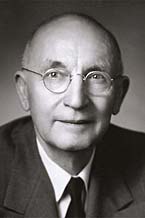Halbert P. Bybee (1888-1957)
 Hal Bybee was born near Rochester, Indiana, on January 7, 1888. Following completion of his BS degree from Rochester College, Indiana, in 1908, he served as the principal of a high school for a year. Then, after a semester at Indiana University, he served as a science instructor at Clinton College, Clinton, Kentucky. Subsequently Bybee completed his BA degree at Indiana University in 1912, his MA in 1913, and his PhD in 1915.
Hal Bybee was born near Rochester, Indiana, on January 7, 1888. Following completion of his BS degree from Rochester College, Indiana, in 1908, he served as the principal of a high school for a year. Then, after a semester at Indiana University, he served as a science instructor at Clinton College, Clinton, Kentucky. Subsequently Bybee completed his BA degree at Indiana University in 1912, his MA in 1913, and his PhD in 1915.
In 1914 Dr. Bybee married Ruth Woolery and became an Instructor in the Department of Geology at UT for the spring semester. At this time the department had one professor and three instructors. In the fall of 1914 Bybee began teaching at Washington University in St. Louis in order to be closer to his home and that of his bride. Owing to a heavy increase in enrollment at UT, departmental Chairman F.W. Simonds induced Bybee to return to UT in mid-semester with approval of the administration at Washington University. Bybee was promoted to Adjunct Professor in 1916 and Associate Professor in 1920.
Bybee taught introductory geology, mineralogy, and other basic courses. Because he had a strong belief in the value of applied geology, he initiated the first summer field camp in geology in 1917- a program that continues today. Bybee also initiated a course in petroleum geology, one of the first such courses to be offered in the USA. Graduates of UT were soon in demand by the petroleum industry.
During the summers of 1915 and 1916 Dr. Bybee worked for the Bureau of Economic Geology on the Thrall Oil Field; in the summer of 1925 he worked on the Lytton Spring Oil Field, and in 1918 and 1920 he worked for the Oklahoma Geological Survey on oil fields in that state.
Financial considerations and the drowning death of his son, Henry, led Dr. Bybee to resign from UT and join the Dixie Oil company in San Angelo, Texas, in 1925. Bybee became a leading petroleum geologist in West Texas and helped organize the West Texas Geological Society, serving as it president in 1927. In 1929 the regents of UT chose Bybee to serve as the first Geologist-in-charge of the 2,000,000 acres of University lands, many of which produced petroleum and generated critical income for the UT System.
Dr. Bybee returned to the faculty at UT as Professor in 1936, serving as Chairman from 1937 to 1941, while continuing to direct the work of the University lands. He served in this dual role until ill health forced him to relinquish the latter position in 1954, although he continued to serve as a consultant to the position until his death on March 30, 1957. Bybee supervised 52 MA students and one PhD student during his UT career.